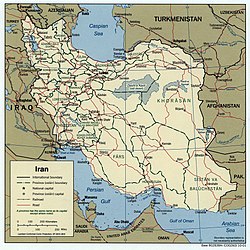
Iran has a long paved road system linking most of its towns and all of its cities. In 2011 the country had 173,000 kilometres (107,000 mi) of roads, of which 73% were paved.[1] In 2008 there were nearly 100 passenger cars for every 1,000 inhabitants.[2]
Trains operate on 11,106 km (6,942 mi) of railroad track.[3] The country's major port of entry is Bandar-Abbas on the Strait of Hormuz. After arriving in Iran, imported goods are distributed throughout the country by trucks and freight trains. The Tehran–Bandar-Abbas railroad, opened in 1995, connects Bandar-Abbas to the railroad system of Central Asia via Tehran and Mashhad. Other major ports include Bandar e-Anzali and Bandar e-Torkeman on the Caspian Sea and Khorramshahr and Bandar-e Emam Khomeyni on the Persian Gulf.
Dozens of cities have airports that serve passenger and cargo planes. Iran Air, the national airline, was founded in 1962 and operates domestic and international flights.
Transport in Iran is inexpensive because of the government's subsidization of the price of gasoline. The downside is a huge draw on government coffers, economic inefficiency because of highly wasteful consumption patterns, contraband with neighboring countries and air pollution. In 2008, more than one million people worked in the transportation sector, accounting for 9% of GDP.[4]
- ^ "The Business Year - Moving Around". Archived from the original on 2014-03-14. Retrieved 2014-03-14.
- ^ "Iran Daily - Domestic Economy - 06/12/07". iran-daily.com. Archived from the original on June 18, 2009.
- ^ "Islamic Republic Of Iran Railroads :: راه آهن جمهوري اسلامي ايران". Rai.ir. Archived from the original on 2012-08-15. Retrieved 2012-02-09.
- ^ "Iran Daily - Domestic Economy - 12/21/08". www.iran-daily.com. Archived from the original on June 3, 2009.